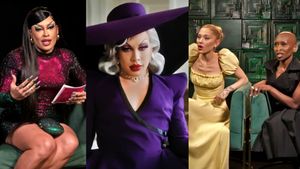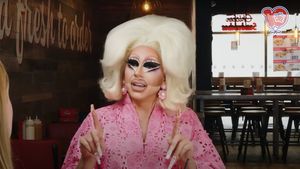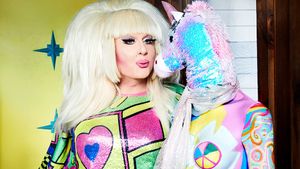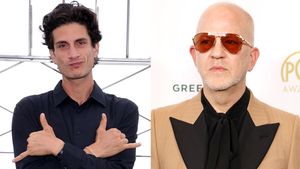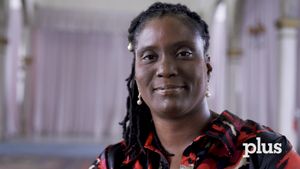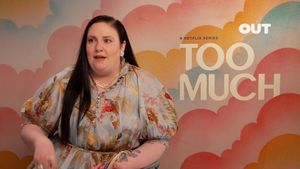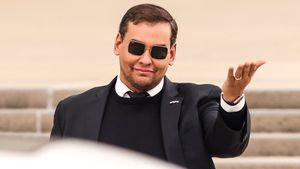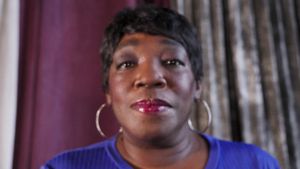CONTACTAbout UsCAREER OPPORTUNITIESADVERTISE WITH USPRIVACY POLICYPRIVACY PREFERENCESTERMS OF USELEGAL NOTICE
© 2025 Equal Entertainment LLC.
All Rights reserved
All Rights reserved
By continuing to use our site, you agree to our Privacy Policy and Terms of Use.
We need your help
Your support makes The Advocate's original LGBTQ+ reporting possible. Become a member today to help us continue this work.
Your support makes The Advocate's original LGBTQ+ reporting possible. Become a member today to help us continue this work.
Granted unprecedented access to the Broadway audition process, directors James D. Stern and Adam Del Deo sent camera crews all over the tryouts for the 2006 Broadway revival of A Chorus Line. Since the show itself is about an audition, the whole process became what Del Deo calls an "organic mirror."
The result was Every Little Step, a documentary that dazzled critics and Chorus Line fans alike. And for those fans who wish the movie had spent more time talking about Michael Bennett's legendary 1975 production -- which won nine Tony awards and a Pulitzer, among other honors -- the DVD extras feature lots of goodies, including audiotapes of the original all-night dancers' gabfest that formed the basis of the show and extended interviews with Donna McKechnie and other original cast members.
Stern has a deep Broadway background, having produced such stage hits as The Producers, Hairspray, Legally Blonde, and Stomp, but for Del Deo, making the film was a fascinating learning process about what goes on behind the scenes of the Great White Way.
Advocate.com: Everyone I know who has seen the film loves it -- and almost all of them cried -- but the more hard-core theater people wanted more about the original production. But now that I see the deleted scenes on the DVD, it's clear you guys covered that but then had to cut it for time.
Adam Del Deo: When [revival producer] John Breglio called Jim Stern and asked if he was interested in making the film, before they were launching the auditions for the revival of A Chorus Line, Jim and I wanted to have a strong a take on what we thought we could get accomplished. We talked about a lot of different versions that we could explore for the film, and we decided the strongest take for us was the idea of crafting the film of trials of dancers living in New York, sacrificing everything, doing what they love, their hopes and dreams of working on Broadway. And what we loved was that Michael Bennett had created a play about people sacrificing everything, doing what they love, their hopes and dreams of working on Broadway. The fact that we had an organic mirror, we thought it would be interesting to take both of those worlds and intercut the auditions for the contemporary version with the creation of the original.
We talked a lot about Federico Fellini's 8 1/2. We knew there were a lot of ways to approach the film, but for us as directors, from the outset, that was the film we were trying to create. Something that would appeal not only to hard-core aficionados of A Chorus Line, but also enough of an openness that if you'd never heard of A Chorus Line, you could go in and watch the film and still enjoy it.
I can only imagine all the footage you had to cull through -- we see the
people vying to play a handful characters in the show, and I imagine
you could have told similar stories for all 20 or so roles.
We shot
over 400 hours of footage, so once we had that we had to construct
story lines for certain characters. But we went in knowing that certain
characters in that play resonate stronger than others. So we knew we
definitely wanted to focus on the Val character [the "Dance: Ten; Looks: Three" girl who sings about getting "tits and ass"], Paul [the gay guy],
[veteran dancer] Cassie -- those characters we tended to follow in the
audition process all the way throughout, heavy-handed with our cameras
for those roles that were most present in the play.
Jim obviously has a deep theater background. How familiar were you with this world going into the project?
I
was familiar with it but not nearly as familiar with it as Jim. I don't
have a pedigree in theater. I'm much younger than Jim, so I think I was 4 when A Chorus Line first landed on Broadway. But Jim and I had
directed two films before, The Year of the Yao and ...So Goes the Nation,
so we're very comfortable as directing partners working together. My
familiarity was, I grew up in Phoenix, and my mother and sister liked
Broadway musicals and would play [the cast album] around the house, and
I had seen it when it was touring when I was younger with my family.
I
think my strength was that it hopefully ended up being a film that
could be enjoyed by audience members that weren't so familiar with [A
Chorus Line]. We tried to hit that perfect balance after many, many
months of trying to make that perfect film. I was definitely playing
the part of someone who wasn't so inside that world.
You guys
had unprecedented access to a Broadway audition. And obviously, you're
dealing with a generation who have come up on reality TV and are more
comfortable on camera, but was there anyone who said, "I don't want you
to film my audition"?
Ninety-nine-point-nine percent of the
people were comfortable with it. I'd say out of the 3,000 people who
auditioned, I could count on both hands the people who wouldn't sign
the release. But of all the characters that we followed in those
auditions, there were no issues with those performers. Equity just had
us explain to everyone what was happening and to let them know they had
the right to sign or not to sign. There was no friction whatsoever. You
mention reality TV -- we were also aware of the popularity of American
Idol and how big that show is. Quite honestly, we didn't want this to
feel like the American Idol auditions, but ultimately, what Michael
created is so resonant and timeless that it wasn't an issue.
Most
people agree that the movie version of A Chorus Line is pretty
terrible, but I was surprised that it wasn't even mentioned in the
history of the show, particularly since the auditioners were probably
too young to have seen the stage version in its original run and were
likely familiar with the film.
It wasn't a conscious decision -- we
weren't opposed to it. As we winnowed down in the editing process what
the film was, it didn't fit with the movie we were making. It was too
off-message. We had so many versions of this movie that we showed to
people close to us, and in the case of a film like this, we found the
editing was really critical -- you could have one scene that would make
the film feel it was moving too slowly, and then you could pull a
couple of scenes out and it would feel completely different. It was
just one of those things that didn't make it in.
You guys
obviously lucked out with Jessica, a dancer who you followed from the
very beginning who makes it all the way through. How many people like
her did you have to shoot in order to get the one that got the part?
A
lot, I mean, it was like 70 or 80 people we were tracking from the
get-go. We had 10 camera crews at that open call where 3,000 people
went through. So throughout the day you'd be shooting, say, three or
four people auditioning for the role of Kristine, but by the end of
the day, some might advance to the next stage and some might not. We
just shot as much as we could, and while cuts were being made we kept
shooting and really amped it up toward the end of the process.
In
observing the process, what did you pick up on how the show has aged?
Parts of it are timeless, but there are certain aspects to it that are
very me-decade, mid '70s. Paul's big coming-out story was really
groundbreaking for the time, but for some modern audiences, it's almost
quaint. I wonder if those issues came up in mounting the revival.
Jim
and I were just documenting what was happening with that team. What we
did experience in watching John the producer and Bob Avian the director
and [revival choreographer] Baayork Lee was that they wanted to create
something that was pretty much by and large true to the original. There
were a handful of adjustments here and there, but it's a pretty fairly
strict interpretation overall. And it was interesting, when making the
casting decisions, you'd hear Bob say, and the group discuss -- if they
couldn't ultimately decide on something -- they'd ask themselves, What
would Michael Bennett want? The ghost of Michael Bennett was really
present throughout the whole mounting of this production, and I really
felt they all wanted to create something that, if Michael were here
today, he would be very proud of and he would approve of. So that, from
a filmmaker point of view, was interesting to watch.
What
surprised you most over the filmmaking process, in terms of what you
might have gone in thinking about the story you were going to tell or
how the auditions were going to play out?
For me personally, the
most surprising thing -- not coming from a Broadway background -- I couldn't
believe seeing 3,000 people standing in a line winding around a
building, knowing that there were only, with understudies, 20 or so
parts available. The math, right out of the gate, was bizarre to me. I
was like, "Wow, there's this many spots, and this many people." The vibe
was just so passionate, and whatever it means to need to act, to dance,
to perform on Broadway, it's just such a powerful thing. And to see the
sacrifice that people were willing to make, knowing that such a very
small percentage of this group was going to be cast in a role, and all
those other people who aren't going to get a part are going to get up
the next day and spend their pennies that they have on dance teachers
and acting coaches and trying to better themselves in the hopes of
getting work. What I learned is that even if you get cast on Broadway,
those actors don't make a whole lot of money, so really, I know it
sounds cliched and on-point, but like the song says, it's "What I Did
for Love." They're doing what they have to do. Michael Bennett
dedicated the show "to anyone who has ever danced in a chorus or
marched in step ... anywhere." That resonated so strongly throughout that
process. Now, whenever I meet someone who's a Broadway dancer or a
Broadway singer, I'm just, "Hats off."
From our Sponsors
Most Popular
Watch Now: Pride Today
Latest Stories
How the Black AIDS Institute continues to fill in the gaps
July 25 2025 1:06 PM
Kim Davis is trying to get the Supreme Court to overturn marriage equality
July 25 2025 11:45 AM
Queer celebrity chef Anne Burrell's death ruled a suicide
July 24 2025 3:14 PM
Anti-LGBTQ+ mom in Oregon wins right to potentially adopt LGBTQ+ kids
July 25 2025 1:06 PM
Phoenix LGBTQ+ film fest canceled because of Trump's anti-DEI orders
July 25 2025 5:00 AM






























